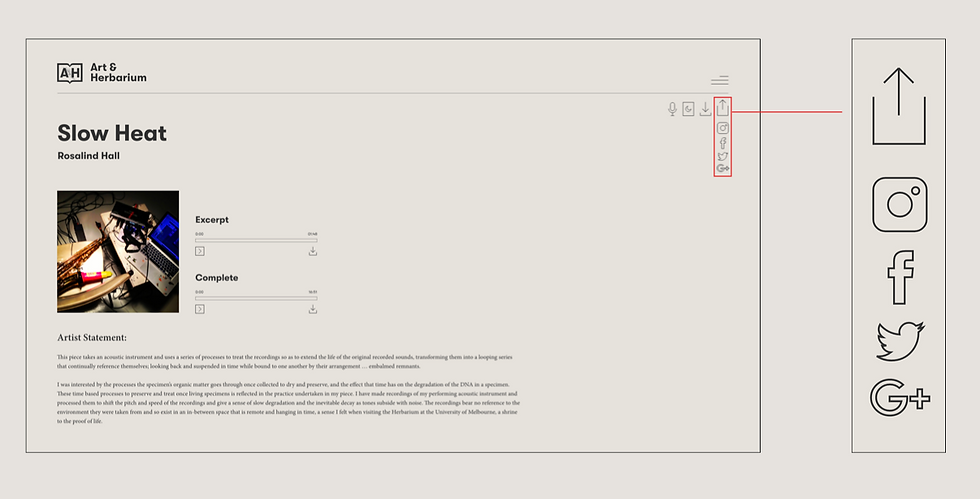Art & Herbarium - An E-book for some disabled people
- Yao Zhang
- Oct 13, 2020
- 4 min read
Along with the development of technology, a growing number of people started to read book or receive some information via website or other digital platforms. In order to help people can insight into exhibition of art and herbarium and enhance reading experience, a new electronic publication may be a good strategy not only to achieve these goals but promote the knowledge of herbarium currently.
However, I always believe human can create the ‘unimaginative’ carrier enhancing or switching people’s reading behaviour in the future. In addition, from my point of view, a good design is not just for general people, some disabled groups (or vulnerable groups, like blind people and physical disabilities) should be considered. Therefore, I designed this e-publication not only is based on user experience and user interface design theories, but the critical design was discussed in my artwork. Critical design thinking always focus on a social impact and solve relevant problem via purposeful design or targeted function creating. Moreover, some advantages should be extracted from general website and printed book to enhance practicability of this new e-publication. Based on the combination of these theories and multimedia functions, I designed this e-publication via some ‘cool’ functions to help the disabled and general public, like voice assistant, read modes switch, and different images’ mode etc. (All these functions were demonstrated in the demo video.)
Branding
I created a new brand for Art & Herbarium from a logo mark to readable typefaces and friendly colour scheme. The aims of this brand are distinguishing this e-publication with other website, meanwhile, using gentle colour and general typefaces which utilized at printed book to restore a ‘real’ book and break the boundary between real world and internet. Through modernist typography and exploring advantages of traditional book and e-book, I created the structure of the whole e-publication. I hope Art & Herbarium is not just a website like other e-journal, it can be a new platform to connect different people and redefine functional e-publication to fit for more audiences’ reading behaviours.

User Interface Design
Voice Assistant
There is a microphone icon at every individual page. Audiences can say ‘Hi’ to activate it, meanwhile, this is a very essential function to help disabled groups to read our e-publication or the information and functions displayed on the pages. In terms of images, every photos or images should have the description (not just words and graphs layout, but some info to explain colours’ feeling). Critical design thinking is considered in this design to eliminate the despising of vulnerable group. Not only blind audience (or visual impairment people) can use this function, but general people can obtain the benefit. (the words like ‘blind’ or ‘disabled’ used in this document just are the temporary words to represent these audiences, but I think all audiences are equal that cannot be distinguished by these words.)

Day Mode/ Night Mode
To protect audiences’ eyes and help them reading anywhere, I created day mode and night mode which audiences can switch the modes based on the different reading environment. Actually, some people who had amblyopia also can reduce the hurt from screen.

Take Notes
Taking notes is an obvious trait to distinguish printed book and e-book, since we can write or draw anything on the paper. Therefore, I leave the margin to take notes and use these negative spaces as much as possible rather than almost general websites contained large ‘free’ spaces. Audiences can type some words here, as well as some people who use touchpad can draw any graphs. It is worth nothing that the notes are private just for your own, audiences can download it or share it. Generally, when the audience jump to this page at first time, there is not any notes from other people except some official references and explanations, since website cannot save users’ info to protect users’ private info, namely like customization function.

Bookmark System
When we read a book, we can use a card or physical bookmark to record where we read. In Art & Herbarium e-book, audiences also can mark anywhere. Next time audience can continue to read from last place. Of course, some cookie issues should be considered at this function, because background system have to save marked place information by coding.

Sharing
Actually, social media has played a very important role to connect and communicate with different people, including friends, colleagues, and family members. A specific button was built to share the info of A&H with others, which included some mainstream social platforms. In fact, everything can be shared via this button from essays to audios.

Rational Catalogue
Compared with the website and general e-book, traditional book always has a detailed content to help users find the exact pages. To achieve the target of ‘easy searching’, A catalogue has been designed, which can be divided into two main streams ‘Index’ and ‘Artists’ to fit for different users’ behaviours.

Different Image Modes
Different people may have diverse behaviours of reading images. For example, someone likes reading from first page to the last, others prefer preview all pictures then select the one they liked. Based on these behaviours, I designed two main image modes ‘complete story mode’ and ‘separate pages mode’. Audiences can select the modes they preferred.




Comments